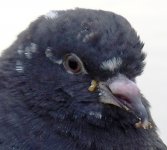Just a note on Feral Pigeons "deformed" feet:
I've had over 60 Pigeons in my garden for years, and I see them appear as juveniles with all appendages intact. But the majority (60%+ of the 60+ ATM) end up without toes, feet, or one leg.
I've heard a number of theories as to why this happens; Genes, disease, acidic droppings, but the most common cause is messy Humans. Look closely at a Pigeon with half a toe, and you'll see string or nylon tightly wound around the toe. This cuts off the blood supply to the toe (or foot, or leg, depending where it's wound around), and the toe/foot dies and drops off. Actually it goes white first, then floppy, and then it drops off. I would imagine this is extremely painful for the affected bird.
Oh, the "string or nylon"? People discard rubbish in the street, cotton seems quite popular, though I've no idea why. Over the years I've unwound and cut string/nylon from many Feral Pigeons, and I like to think that I've saved a few toes/legs/feet. Incidentally; most of the birds were hobbled by the string, and couldn't even stand for long. Some, if it's cotton/nylon instead of string, also get things caught around the cotton, like twigs.
Another reason for losing toes seems to be toxicity of some roosting repellents; there is evidence for this if you Google it. I've found no evidence that walking in their droppings burns Pigeons' toes off.
Of course, it's the stupid Pigeons own fault for feeding on the rubbish we discard.





